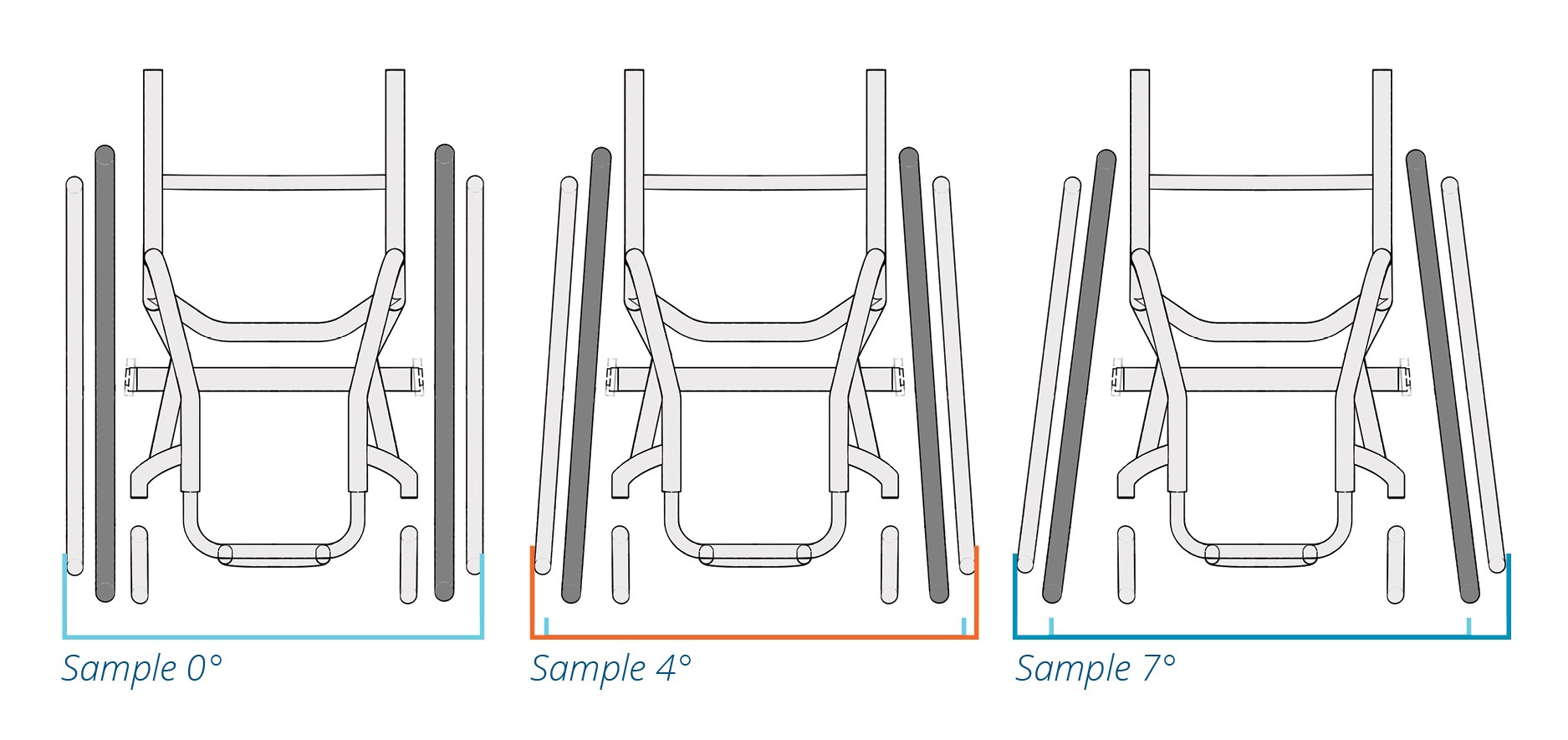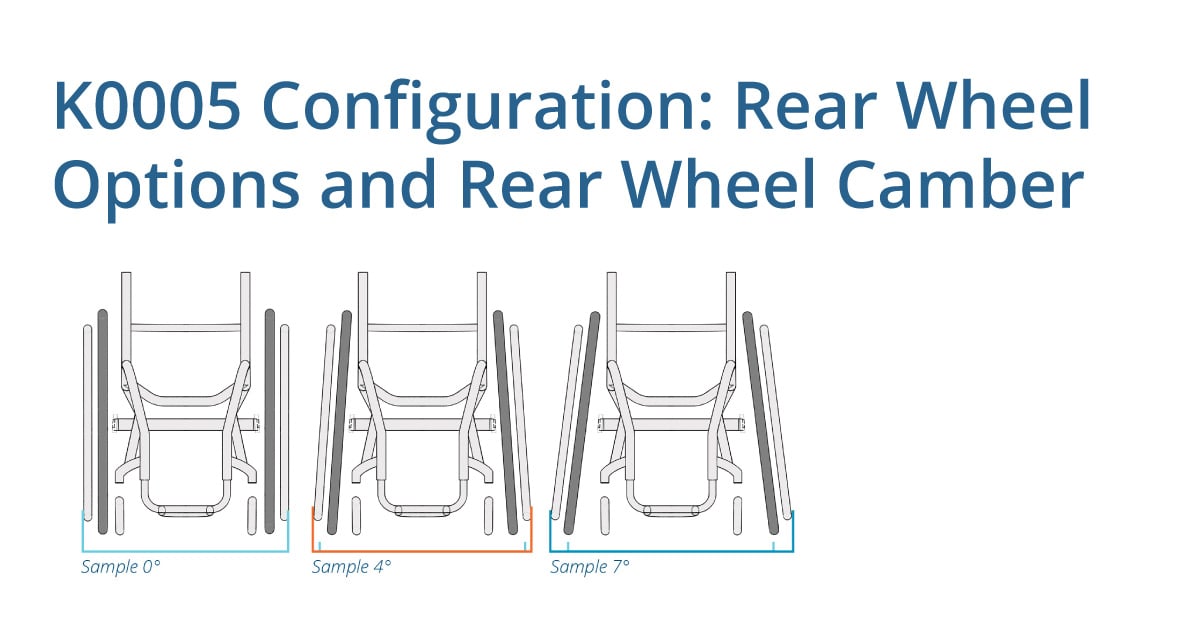We continue looking at configuring a K0005 wheelchair to an individual. So far we've discussed seat-to-floor height, seat slope, ergo seat, foot support-to-length, front frame angle, seat width, front seat width, footrest width, seat sling depth, frame depth, seat back height, seat-to-back angle, and axle positioning. Today we're looking at rear wheel options and rear wheel camber.
Rear Wheel Options
In terms of wheel type and size, the wheels and tires are important to minimize rolling resistance, decrease weight and inertia, and increase reliability of the system.
Rear wheel size
Diameter of the wheel is determined by the optimal RSTFH for a client. For example, a taller person may need a larger diameter wheel.
Rear wheels - too large
- The seat-to-floor height and access to the hand rims may be compromised
- A larger diameter wheel may interfere with transfers since they create a little bit bigger hurdle to transfer over
- A larger wheel will increase the length of the wheelchair footprint. This could negatively affect ADLs and wheelchair maneuverability
Tire styles
Pneumatic tires: (filled with compressed air)
- Weigh less
- Better shock absorption
- Need to be inflated properly for optimal propulsion
Non-pneumatic tire:
- May be solid or pneumatic with flat-free inserts
- Often used when a wheelchair user or their family is unable to properly maintain proper inflation of a pneumatic tire.
| * Choose a wheel and tire that is lightweight to decrease the initial force required to turn the wheels. Low tread, less surface contact to the ground and light weight decrease rolling resistance and inertia. |
Rear Wheel Camber
Camber is the inward tilt of the rear wheel. The camber angle affects lateral stability and the efficiency of propulsion as well as rear wheel access. When performing tasks that require leaning outside the footprint of the wheelchair, increased camber will increase stability and promote maintaining an upright position in the wheelchair.
 Most adult wheelchairs used for daily use have 0° - 3° of camber while pediatric sizes may have more to improve wheel access. Wheel camber decreases proximal distance to the user at the top for wheel while increasing distance between wheels at ground level.
Most adult wheelchairs used for daily use have 0° - 3° of camber while pediatric sizes may have more to improve wheel access. Wheel camber decreases proximal distance to the user at the top for wheel while increasing distance between wheels at ground level.
Sports WCs have greater than 3° degrees camber for stability. The extra wide camber also increases the ease of propulsion (longer leaver arm).
Rear wheel spacing is the distance between the top of the wheel and the back post. The goal is the narrowest possible configuration to allow the most accessibility.
- Different amounts of rear wheel spacing is required for different camber angles and wheel/tire configurations
| * Remember that adding camber will increase the overall width footprint of the wheelchair. |
 Stacey Mullis, OTR/ATP
Stacey Mullis, OTR/ATP
Director of Clinical Marketing
Stacey serves as Director of Clinical Marketing for Permobil. A practicing OTR for over 20 years, she has experience in school-based pediatrics, inpatient rehabilitation, long term care, and home health. With her interest in wheelchair seating and positioning, Stacey engaged the challenges of providing appropriate seating in various clinical settings. She now uses this experience to develop programs and resources to educate clinicians on the principles of seating and wheeled mobility. She is passionate about equipping clinicians and through her previous role as Director of Clinical Education with Comfort Company and now with Permobil she has taught nationally and internationally to increase therapist capacity in this specialty area. Mullis graduated from Western University in London, Ontario, Canada with a BA Linguistics and BSc Occupational Therapy. She is a member of the NCOTA, CTF Executive Board, NRRTs, RESNA, and AOTA.
 Ginger Walls, PT, MS, NCS, ATP/SMS
Ginger Walls, PT, MS, NCS, ATP/SMS
Director of Clinical Sales and Education
Ginger has 25 years of experience as a physical therapist in the area of neuro rehab and wheelchair seating/mobility. She directed the Outpatient therapy clinics and the Seating/Mobility Program at Medstar National Rehabilitation Hospital in Washington, D.C. Additionally, Ginger has provided a variety of continuing education courses and lectures in the area of seating/mobility for many years. She has presented at major industry conferences including ISS, RESNA, and the PVA Summit. Ginger took on the role of Clinical Education Specialist for Permobil in 2015 and was appointed Director of Clinical Sales and Education in 2020.
